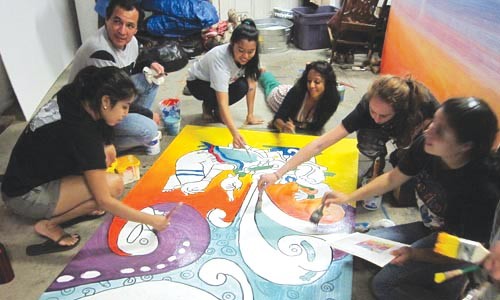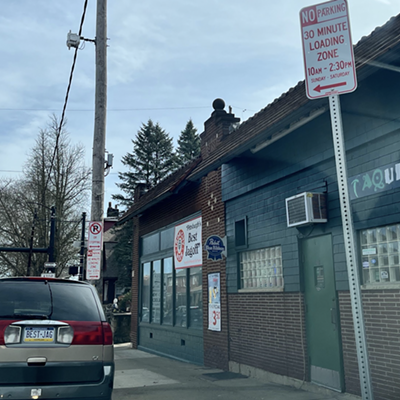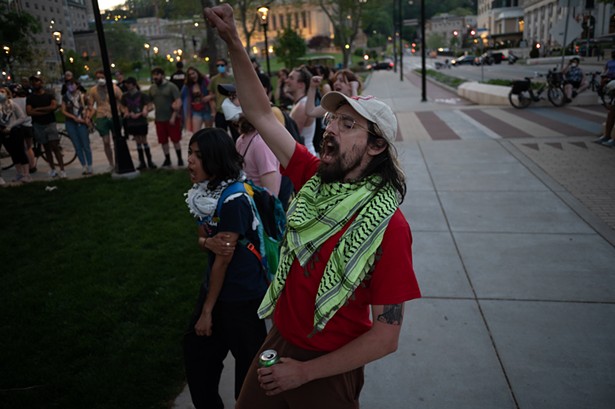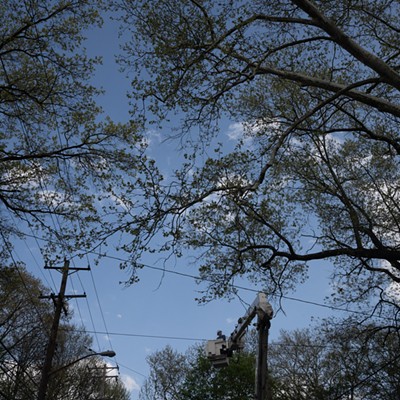After a tough election night this November, supporters of immigration reform -- and many immigrants themselves -- saw a glimmer of hope Nov. 13, inside East Liberty's Ava Lounge.
The event was the unveiling of what may well be Pittsburgh's first Latino mural: "Pintando para un Sueño" ("Painting for a Dream").
Created by local immigrant youth and suffused with a golden light, the panel displayed -- one of five that make up the full-length, 36-foot-long work -- spoke for a community whose voice is often silent. Featuring Lady Liberty, an ancient pyramid, and a young man in graduation cap and gown, it spoke to a range of critical issues: immigration, cultural identity and access to education.
"Let this mural be a call of reflection and awareness of the growing Latino community here in Pittsburgh and in the United States," one of its creators told an audience of nearly 150. "And let this mural be a spark of hope for all the youth without names."
Not surprisingly, the roughly two dozen members of Jóvenes Sin Nombres (JSN), or Youth Without Names, are wary of identifying themselves by name. But the organization strives to bring the national debate on immigration to the local level.
JSN formed two years ago, when co-founders Alfonso Barquera and Michal Friedman saw that Latino youth -- a growing yet still-marginalized group in Pittsburgh -- needed a safe space to discuss issues affecting them. Friedman notes that some JSN members came to Pittsburgh without any relatives, and are especially in need of support. JSN was created to help provide that isolated community with a network.
"The jóvenes came pouring in from our local high schools and universities, and from their often invisible workplaces," Friedman explained at the mural unveiling. "[T]hey arrived with all their infectious energy, enthusiasm, intelligence and talent."
Based on recent events, they are going to need it all. Less than two weeks before the mural's unveiling, voters in Pennsylvania and across the country elected a slew of politicians with anti-immigrant voting records.
The state's governor-elect, Tom Corbett, has vocally supported Arizona's SB 1070, a controversial bill which steps up local and state enforcement of immigration laws. The Senator-elect, Pat Toomey, has earned a 100 percent rating from FAIR, an advocacy group that takes a hard-line approach to immigration. And in eastern Pennsylvania, voters elected to Congress Lou Barletta, who, as mayor of Hazelton, Pa., supported anti-immigrant ordinances and boasted of representing the nation's "toughest place on illegal immigrants."
A central theme in the mural is the Development, Relief and Education for Alien Minors (DREAM) Act, which allows states to provide college loans and other assistance to children in whose parents are undocumented. The measure would also permit those children to join the military and eventually to become citizens.
"It's not just a pretty mural," explains Juan, 19, a JSN member and student at the Community College of Allegheny County. "It has meaning and symbolism. Maybe [the mural] will raise questions about what the DREAM Act is, and what kids like me and other members of the group go through."
JSN has taken that message beyond city limits. When Congress convened for its post-election lame-duck session, "Pintando para un Sueño" was installed outside Pittsburgh's Latino Family Center, in hopes the Senate would vote on the DREAM Act.
As this issue goes to press, the Senate had taken no action, and the bill's prospects looked dim. But Congress isn't the only option. According to the American Civil Liberties Union, at least 10 states have already enacted legislation permitting undocumented students to attend public universities at the cheaper "in-state" rate given to residents. Pennsylvania is not among them, though some colleges here offer private help.
"It's not illegal to admit undocumented students or award them private financial aid," says David McFarland, director of admissions at La Roche College. "But for undocumented students, that's all the financial aid they're going to get." And in fact, he adds, "To my knowledge, we haven't had any students that actually attended La Roche" on such a scholarship.
The mural project, whose artistic direction is by Tavia La Follette, director of the nonprofit group ArtUp, garnered support from organizations including the Carnegie Museum of Art and The Center for the Arts in Society, which hosted workshops on muralist traditions. Both institutions said their goal was to extend resources to all Pittsburghers, not to make a political statement.
"The Center pays for pizza and paint, not for buses to political rallies," says Paul Eiss, director of Carnegie Mellon University's Center for Arts in Society. Still, he says, "In some ways, the work that JSN is doing is political in a deeper way" because it "is informed by a hope for social change and recognition."
Outside the Ava Lounge unveiling, JSN co-founder Alfonso Barquera said that, if nothing else, Pittsburghers have a better sense of what an immigrant community is all about.
"I'm sure that the Pittsburgh community is going to be as proud as I am of them," he said, "because they are really the future of this community."















